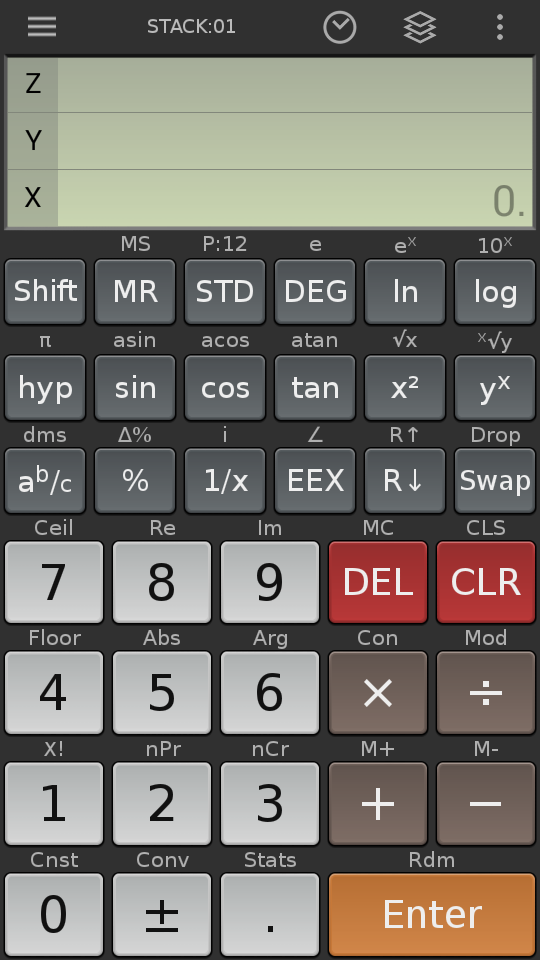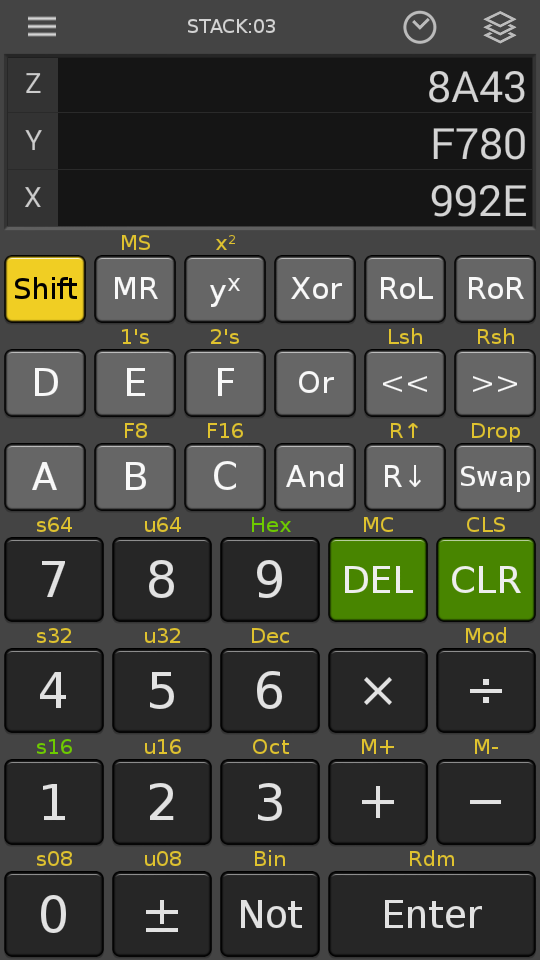A few of the pros and cons of some scientific calculators that I've tried. I've installed (and deleted) others but these are the more note-worthy (either because I like them, find them intriguing, or absolutely loathe them). Click on the images to get magnified versions.
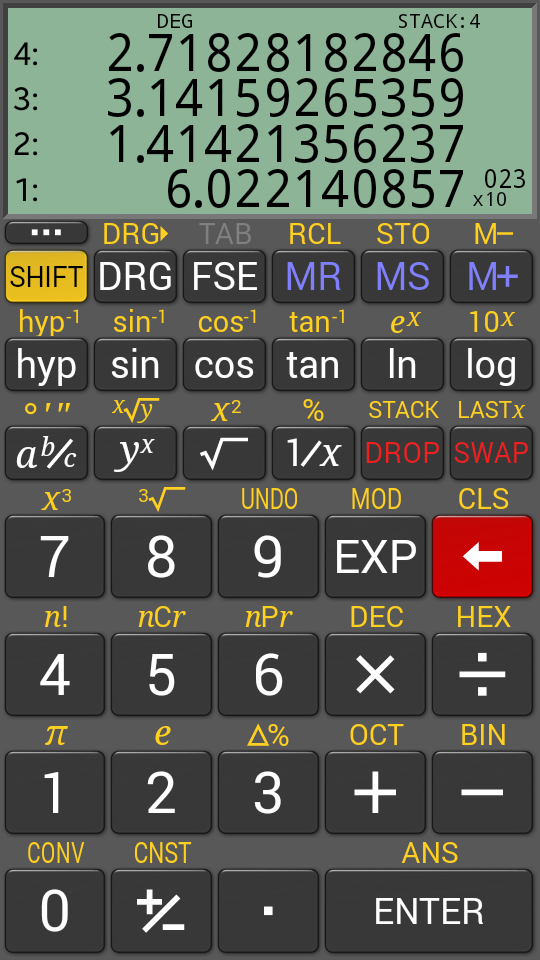
I've been using RealCalc for a few years and so I'm biased toward it and tend to use it as my benchmark
- Pros:
- Has RPN mode
- In RPN mode, number of registers shown is adjustable just by sliding up/down. Max of 4 on my phone.
- Binary, hex, octal functions included in free version
- Customizable unit conversions and constants
- Cons:
- No random number generator
- Only one RPN style available in free verison, two other options only in paid version
- Fractions capability only in paid version
- 12-digit display is only in the paid version
- Doesn't keep a history of numerical operations, only the numerical results
- Rectangular / polar conversion not available
- one default theme/skin (but it's sufficient with clear and crisp labels on the calculator keys)
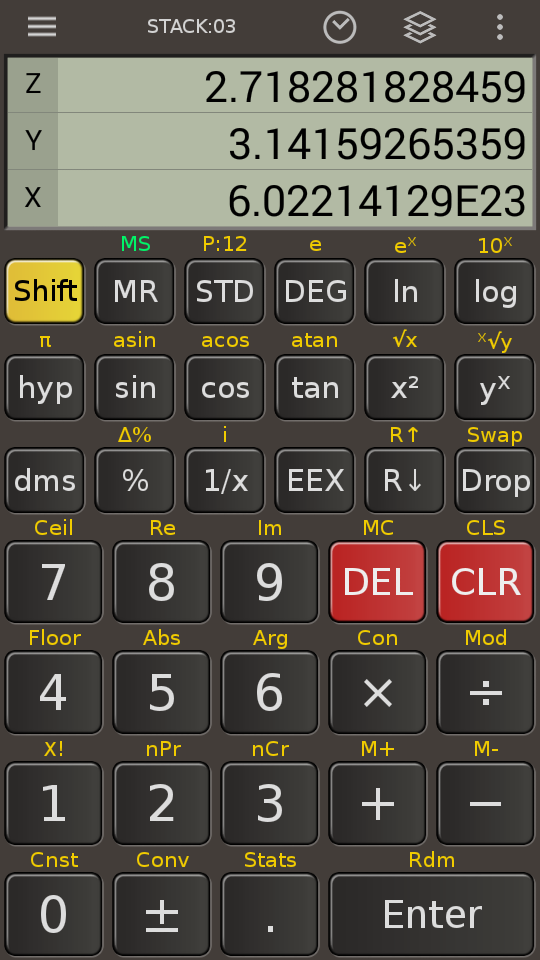
- Pros:
- Has RPN mode
- Has random number generator
- Can generate random numbers (integers) from 0 to x, where x = any integer
- Conversion function (eg., convert from m/s to mph, temp from F to K) has far more units than RealCalc
- The numbers and operations being keyed in (before pressing the equals key) is shown on an upper line with the intermediate and final result shown on the lower line.
- Keeps a history of the operations (eg. multiplication, log, square root) performed, not just the numerical results of those operations
- Stack is accessible even in Algebraic mode
- Has rudimentary statistics package
- Stack doubles as data storage for statistics package (which includes min, max, mean, median, variance, std deviation)
- Can handle complex numbers
- User-selectable theme/skin
- Cons:
- "CalcTastic"?! Seriously?
- Number of lines displayed is fixed. On my phone it's 3 lines of registers in RPN mode and two lines in Algebraic mode
- Binary, hex, octal functions only in paid version
- Rectangular / polar conversion only in paid version
- Fractions capability only in paid version

- Pros:
- The number of significant figures makes me giddy: 15 digits on a phone in portrait mode and 32 in landscape mode, with the paid version extending that to 100, and the exponent's from three to nine digits.
- Free version already has fractions capabilities
- Has random number generator
- Keeps a history of the operations (eg. multiplication, log, square root) performed, not just the numerical results of those operations
- The numbers and operations being keyed in (before pressing the equals key) is shown on an upper line with the intermediate and final result shown on the lower line.
- Has an Engineering SI mode! It will, for example, show 10,000 as 10 k, 5.7 million as 5.7 M, 0.000764 as 764 u [symbol for micro]. Quite useful for electronics designers who have to deal with capacitances in picofarads, nanofarads, microfarads, resistances in kilohms and megaohms, currents in microamps and milliamperes. It just isn't natural for them to say, "I need a 2.2 million ohm resistor" or "1 x 10-9 ceramic capacitor."
- Binary, hex, octal functions included in free version
- User-selectable theme/skin
- Cons:
- No RPN mode (heartbreaking!)
- For trigonometric functions and logarithms, among others, Hiper uses infix notation, ie., you have to press, for instance the "cos" key before entering the angle value. Am more used to postfix notation for these functions even in non-RPN calculators.
- Rectangular / polar conversion not available
Calculator++


These two are aesthetically pleasing, but using them is driving me up the wall. Still trying to get on the learning curve. Neither has RPN mode, as far as I can tell.
Calculator++ has a unique way of accessing the alternate functions of each key—sliding one's finger from the middle to one of the corners marked with the alternate functions. It's a nifty method. But for some reason it's implementation is quirky or something's not right with my Samsung or my index finger's a little too big for the 5-inch screen. The thing is, sometimes the slide method works, most often it doesn't. Not encouraging at all.
Natural Calculator allows equations on the screen to be edited. Though theoretically a good idea, I seem to be having a problem deciphering how exactly it's to be done quickly and efficiently. For now I'm fumbling and am not finding this calculator natural for me at all, having grown up with and gotten used to (semi)postfix calculators.
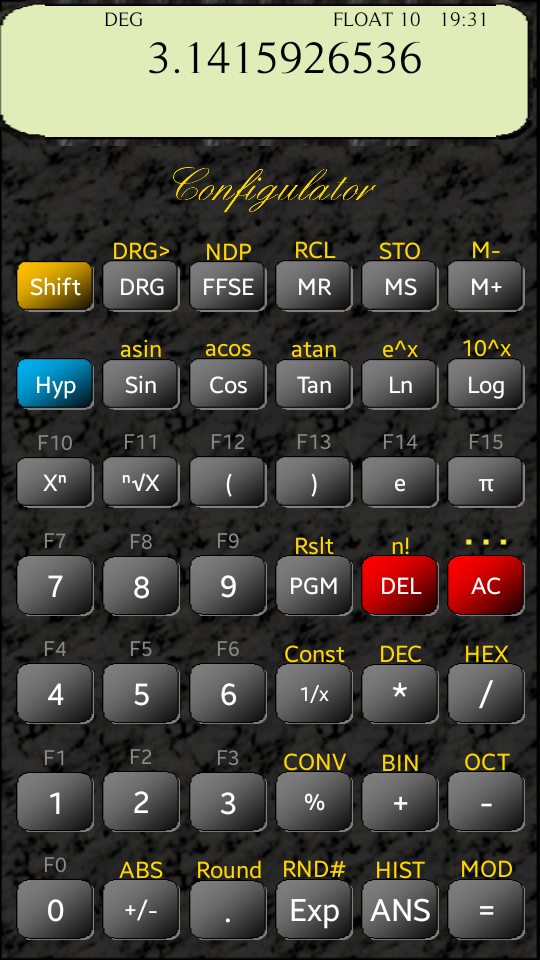
Looks absolutely terrible; it's hideous. I mean, look at that marbly background. And that serif font! What could the app developer have been thinking of?! Frankly, I can't wait to delete this from my phone.
So why did I install it? It advertized itself as having 15 user-definable functions keys. And right now I'm in the market for a programmable scientific calculator, something akin to the Casio FX-502 of decades ago. However, being such a turn-off, I still have to motivate myself to learn how to program those function keys. Perhaps when the time comes that my back's to the wall with my life on the line.
This is one of those apps that only its maker can love.
Between RealCalc and CalcTastic, the latter wins in terms of number of functions. But I'd rather have the look, fonts, key location, layout of RealCalc (must be because of my years of familiarity with it). Now if only CalcTastic could add an Engineering SI mode and extend its signficant figures to something like 50, it would be the winner by a light year.
Addendum [April 2016]: Calctastic's Tavern theme has really grown on me since the review and I now use Calctastic almost exclusively.


